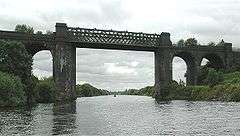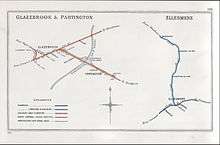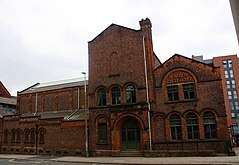Cadishead Viaduct
| Cadishead Viaduct | |
|---|---|
 | |
| Coordinates | 53°25′29″N 2°25′40″W / 53.4246°N 2.4279°WCoordinates: 53°25′29″N 2°25′40″W / 53.4246°N 2.4279°W |
| Carries | Railway line |
| Crosses | Manchester Ship Canal |
| Owner | British Railways Board (Residuary) |
| Maintained by | British Railways Board (Residuary) |
| Characteristics | |
| Material | Black Engineering Brick and Steel |
| Longest span | 120 ft (37 m) |
| No. of spans | 5 |
| Clearance below | 75 ft (23 m) |
| History | |
| Constructed by | Cheshire Lines Committee |
| Opened | 27 February 1893 |
| Closed | 1984 |

Cadishead Viaduct is a disused railway viaduct of multi-lattice girder construction. It was built in 1892 by the Cheshire Lines Committee to clear the newly built Manchester Ship Canal to carry the new deviation of the Glazebrook to Woodley Main Line. The central span is 40 yards (37 m) long, and the clearance is 75 feet (23 m).[1]
It opened to goods on 27 February 1893 and to passenger traffic on 29 May 1893.[1][2]
Following the withdrawal of passenger services in 1964,[3] the line became goods only, and when expensive repairs to the viaduct were needed in the early 1980s, British Rail closed the viaduct and the preceding line towards Glazebrook.
It is now blocked with containers on each end owing to anti-social behaviour and to stop people walking across it, as the deck of the viaduct is in a very bad state with major corrosion setting in on the soffits and trough decking of the major steel span of the viaduct.[4]
See also
References
- 1 2 Dow, George (1962). Great Central, Volume Two: Dominion of Watkin, 1864-1899. Shepperton: Ian Allan. pp. 143, 145. ISBN 0-7110-1469-8.
- ↑ Bridges of the Manchester Ship Canal.
- ↑ The Reshaping of British Railways by Dr Richard Beeching, 1963.
- ↑ BRB (Residuary) Visual Examination Report, 22 April 2009.



